
May 2014
For Proletarian
Opposition to U.S./E.U./NATO Imperialists’ Cold War Drive!
The Bugbear of
“Russian Imperialism”
In the global crisis unleashed by the battle over Ukraine, the imperialists are preparing a new Cold War. In Cold War I following WWII, the target of the West’s military, economic and political threats was the bureaucratically degenerated workers state of the Soviet Union. After a brief interlude of “détente” resulting from the U.S.’ ignominious 1975 defeat in Vietnam, a second anti-Soviet Cold War was launched when Washington provoked Moscow’s intervention in Afghanistan in 1980. Now, two decades after the 1989-92 counterrevolution that brought down the Soviet bloc and broke up the USSR, a looming Cold War III is directed at capitalist Russia. The daily denunciations and sanctions from the U.S. and its NATO allies, along with the hysteria in the imperialist media, are eerily familiar. For now, the threats are mainly verbal, talk of “punishing” Putin for violating the rules of the post-Soviet “New World Order” of unbridled U.S. hegemony.1 But the propaganda war and economic war ultimately presage a shooting war.
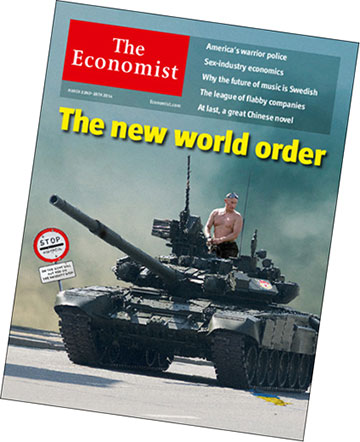
In this conflict, quite a few social-democratic groups echo the Western media, railing against “Russian imperialism” for incorporating Crimea and accusing Moscow of fomenting unrest in eastern Ukraine. They blithely pass over the fact that Crimea has historically been part of Russia and that the overwhelming majority of the Crimean population strongly supported joining Russia. They dismiss the uprisings against the Kiev regime in Donetsk and Lugansk as the work of Russian “provocateurs,” ignoring the clear mass support for self-rule among the largely Russian-speaking population of this industrial region. The claims by these reformists that they also oppose Western imperialism are a cynical cover as they side with the Kiev junta of fascists and free-market ultra-rightists that seized power with the backing of the U.S., NATO and European Union.
Here are some of the refrains from this pseudo-socialist pro-imperialist chorus:
The British Socialist Workers Party (SWPUK) declares “Imperialist rivals push Ukraine to brink of war,” saying “Intervention in Crimea has escalated a deadly game between Russia and the West” (Socialist Worker [UK], 8 March). In the same issue, an article by SWPUK guru Alex Callinicos says that Russian president “Putin is engaging in an inter-imperialist power play” and that fighting imperialism “means opposing Russian intervention in Ukraine.” The British SWP is part of the current founded by the late Tony Cliff, who broke from the Trotskyist Fourth International at the dawn of Cold War I, refusing to defend the Soviet Union against imperialism and justifying this with the claim that the USSR was “state capitalist.”
Another British social-democratic outfit, Workers Liberty (WL), proclaims: “Russia is an imperialist country attempting to negate Ukraine’s self-determination and subordinate it. We support the Ukrainians’ strivings for national freedom just as we support strivings for freedom by other oppressed or potentially oppressed nations” (Workers Liberty website, 17 April). Over the course of the second Cold War in the 1980s, the current that became WL embraced the heritage of another renegade from Trotskyism, Max Shachtman, who broke with Trotsky on the eve of World War II, and refused to defend the USSR against the invasion by Nazi Germany, claiming in justification that the Soviet Union was no kind of workers state but “bureaucratic collectivist.”
In the United States, the leading Cliffite group is the International Socialist Organization (ISO), which declared: “Russian imperialism has made its move to retain political and economic domination over the country with its takeover of Crimea – this should be unconditionally condemned by all revolutionaries claiming to be anti-imperialists” (Socialist Worker [U.S.], 11 March). The ISO vociferously denounced leftists who condemned U.S./NATO imperialism instead of “Russia, Ukraine’s past and present imperial overlord,” and declared that “The right can exploit legitimate hostility to Russian imperialism” (Socialist Worker, 12 March). This is a bald-faced justification of fascist propaganda by Pravy Sektor (Right Sector), Svoboda, et al.2 For its part, the centrist League for the Revolutionary Party (LRP), whose roots go back to the Shachtman tendency, calls to “Defend Ukraine Against Russian Imperialism” (LRP website, 18 March).
It’s no accident that groups coming out of the virulently anti-Soviet Shachtmanite and Cliffite currents are leading the pack howling against “Russian imperialism” today, since they have been doing so since breaking with Trotskyism on the key “Russian question.” It’s notable as well that they all claim that China today is capitalist and some even label it “imperialist,” refusing to defend the Chinese deformed workers state against counterrevolution and the threats and machinations of the real imperialists. Note as well that on the basis of shared anti-Sovietism, both Cliffites and Shachtmanites supported “leftist” offshoots of the fascist Ukrainian Insurgent Army (UPA) founded by Nazi collaborator Stepan Bandera in the post-World War II period when it was kept alive by the U.S. spy agencies.
This points to the second reason why the social-democratic hue and cry over “Russian imperialism” in Ukraine is politically logical: many of these outfits have repeatedly backed all sorts of nationalists and ultra-reactionaries sponsored by Western imperialism. Leftist groups who hailed the CIA’s mercenary mujahedin against Soviet intervention in Afghanistan, who as the USSR was breaking up praised Baltic SS Einsatzgruppen that carried out mass execution of Jews, and who paint as revolutionaries pro-imperialist Islamist jihadis in Libya and Syria have no qualms about siding with a Ukrainian junta composed of rightist puppets of Washington, Wall Street and Eurobankers imposing vicious anti-working class austerity, backed up by squads of fascist killers.

Like the RCA Victor mascot Nipper in the old gramophone logo, in barking against “Russian imperialism,” these “leftist” lap dogs of U.S./NATO imperialism are just echoing “their master’s voice.” Shachtmanites and Cliffites claimed to be in a “Third Camp” during World War II and the anti-Soviet Cold War respectively. While Trotskyists fought tenaciously to defend the Soviet degenerated workers state, despite and against the bureaucratic leadership of Stalin and his heirs whose policies endangered the survival of the first workers state in history, these anti-Trotskyists proclaimed: “Neither Washington nor Moscow.” In reality there was no “third camp” and they ended up as camp followers of the first, imperialist “camp.”
Is Russia Imperialist? I: Monopoly and Export of Capital
Not everyone on the left is repeating the imperialist refrain over Ukraine, but among those who don’t there is little clarity about the nature of the capitalist states that arose out of the counterrevolution that destroyed the multinational Soviet Union. It’s worth asking, is Russia imperialist? Is Putin building a new Russian Empire? So say academic anti-communists like Yale’s sinister Timothy Snyder, who is sympathetically interviewed on “progressive” Democracy Now TV/radio show. Snyder is the author of Bloodlands: Europe Between Hitler and Stalin (Basic Books, 2012) that grotesquely equates the USSR with Nazi Germany. And what about Ukraine and other “post-Soviet” states of Eurasia, are they colonies or semi-colonies whose fate is decided in the Kremlin?
To answer this question, one must first define what imperialism is. Standard bourgeois definitions would include “the principle or policy of empire; the advocacy of holding political dominion or control over dependent territories” (Oxford English Dictionary), “state policy, practice, or advocacy of extending power and dominion, especially by direct territorial acquisition or by gaining political and economic control of other areas” (Encyclopedia Britannica), or more generally “a policy or practice by which a country increases its power by gaining control over other areas of the world” (Merriam-Webster). By these definitions, there was Greek and Roman imperialism in the ancient world, and British, Spanish, Dutch and French imperialism from the dawn of their respective colonial empires in the 16th and 17th centuries. One might add the Aztecs, Incas and the Mughal Empire in India to this list of “imperialisms.”
So how do the “socialist” fustigators of “Russian imperialism” today use the term? The British SWP published a two-page spread on “Imperialism’s Game of Empires” (Socialist Worker [UK], 5 April) in which it defines imperialism as consisting of “control, either direct or indirect, of weaker countries.” This classless definition could apply to any foreign intervention by a powerful country. Even when it says the “driving force” of the “global system” of imperialism is “competition between the big capitalist powers,” in the next breath it claims that the Cold War was a conflict “between capitalist and state capitalist powers,” the latter being their anti-Marxist label for the USSR and the Soviet bloc deformed workers states. For decades, the Cliffites denounced Soviet intervention as “Russian imperialism,” from Korea in the 1950s to Afghanistan in the 1980s, as they lined up with the real imperialists.
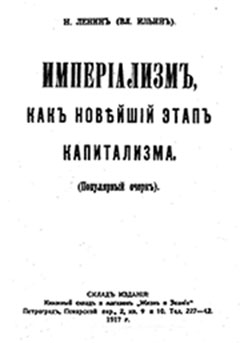
Theirs is a boiled-down version of the standard bourgeois definition, very different from the Marxist, and specifically Leninist definition of imperialism. In his pamphlet, Imperialism, The Highest Stage of Capitalism (1916), Lenin defines capitalist imperialism as follows:
(1) The concentration of production and capital has developed to such a high stage that it has created monopolies which play a decisive role in economic life; (2) the merging of bank capital with industrial capital and the creation, on the basis of this ‘finance capital,’ of a financial oligarchy; (3) the export of capital, as distinguished from the export of commodities, acquires exceptional importance; (4) the formation of international monopolist capitalist associations which share the world among themselves; and (5) the territorial division of the whole world among the biggest capitalist powers is completed.”
The central point of Lenin’s work is that imperialism is not just a policy, which the rulers could change – as opportunists such as Karl Kautsky argued – but rather the stage of monopoly capitalism, in which the dominance of finance capital requires imperialist practices. Kautsky’s definition served to justify his utopian-reformist, pacifist program of pressuring the rulers to adopt peaceful “non-imperialist” policies. Lenin’s analysis laid bare that the only road to peace was to overthrow the imperialist system.
So where does Russia today stand according to these criteria? Certainly, in this land of “oligarchs,” monopolies dominate the Russian economy. Overall, a few hundred large capitalists control about 40% of sales.3 This is partly due to the structure of the economy in which industry (mining, manufacturing, construction and power), with its huge capital requirements and economies of scale, contributes a far larger share of the gross domestic product (37%) than in the United States (20%).4 But mainly it is a reflection of the fact that Russian capitalism has been built on the remains of the centralized, collectivized economy, in which whole industrial sectors and regional distribution chains were controlled by a single enterprise. The monopolies are not particularly large by international capitalist standards, but there are very few small firms.
An Austrian pseudo-Trotskyist, Michael Pröbsting,5 has recently authored an opus titled “Russia as a Great Imperialist Power: The Formation of Russian Monopoly Capital and Its Empire” (Revolutionary Communism, March 2014). Pröbsting argues that Russia is imperialist in the first instance because of the domination of the economy by monopolies, citing Gazprom, Sberbank, Rosneft and Lukoil, and others. This proves nothing. In the era of combined and uneven development, even in semi-colonial capitalist countries monopolies often dominate the economy. Brazil’s Vale Corp. and Mexico’s Cemex and América Móvil outrank Gazprom and Lukoil in foreign assets,6 but that doesn’t make Brazil or Mexico imperialist.
And this is certainly not the dominance of finance capital, the cornerstone of Lenin’s analysis of imperialism. Russia has only 2 of the top 100 banks in the world ranked by total assets, Sberbank (No. 74) and VTB (No. 93), whose combined worth is less than half that of the three Brazilian banks on the list (Itaú Unibanco, Banco do Brasil and Bradesco). Banks constitute a much smaller part of the Russian economy (4% of GDP) than in the U.S. (8% of GDP and 41% of corporate profits) or the rest of the imperialist West, and play little role in directing the economy. Sberbank is a giant savings bank, majority state-owned, which mainly finances majority state-owned firms. VTB, also majority state-owned, is the former Soviet foreign trade bank. Its subsidiaries in ex-Soviet republics focus on financing trade with Russia.
As for export of capital, Russia is in an intermediate position between imperialist countries and neo-colonial countries. Thus Russian total foreign investment amounts to 21% of GDP, far less than Sweden (78% of GDP), Great Britain (74%) France (54%), Germany (46%) or the U.S. (35%), or even Chile (37%); substantially more than Brazil and Mexico (around 10%) and about the same as South Africa (22%).7 In addition, while in imperialist countries foreign investment outside the country (44% of GDP in “developed economies”) almost always exceeds foreign investment inside the country (33% of GDP), in Russia outward foreign direct investment (21% of GDP) is less than inward FDI (26%), though the gap is not nearly as great as with the larger semi-colonial countries where capital inflows can be double or triple the outflows.
Moreover, a large part of the capital outflows from Russia are hardly foreign investment at all, but hiding funds in offshore tax havens. Look at the countries which are the recipients of Russian foreign “investment”: Ukraine, 1.2%; rest of former USSR, 3.1%; but European Union, 64%, of which Cyprus accounts for US$122 billion, or 34% (and in 2012, 43%).8 Cyprus? No center of industry or raw materials supplies, but it is (or was) a tax paradise. The other main destination, the British Virgin Islands (12.8% in 2012), has since dramatically increased its share from US$49 billion to $80 billion as Russian money fled to the British tax haven in the 2013 collapse of the Cyprus banking system. Far from encouraging foreign investment, the Russian government has been appealing to bring this “flight capital” home, to no avail.9
Much of this is capital temporarily parked off-shore, as suggested by the fact that inflows and outflows of capital largely balance out year after year. Thus the accounting firm Ernst & Young did an analysis of movement of Russian funds from 2007 to 2011 (“Capital Outflow from Russia: From Myths to Reality” [2012]), showing US$135 billion movement to offshores and $133 billion from offshores. Their conclusion: “The amount of real capital outflow is overstated by a factor of at least 2x.” Moreover, several leading Russian companies have been divesting themselves of foreign holdings, such as Severstal which is seeking to sell its two U.S. steel plants.10 Asia, Africa and Latin America, there are very few.
The bottom line is that far from having “an enormous ‘surplus of capital’” (Lenin, in Imperialism) that is scouring the globe for more lucrative investments, to corner markets or jack up profit margins by exploiting low-wage labor in semi-colonial countries, Russia has a capital shortage and is a net importer of capital. Only one of the world’s 100 largest “transnational” corporations is Russian (Vimpel.com, No. 93, a cellphone company, with less than half the assets of Brazil’s Vale and the same size as Carlos Slim’s Mexico-based América Móvil). As far as the search for raw materials supplies is concerned, Russia is endowed with vast quantities of almost every vital resource, including the largest natural gas reserves in the world. It is primarily an exporter of raw materials and energy (oil and gas supply 70% of total export earnings). In short, on the criterion of exporting capital, Russia is far from qualifying as an imperialist country.
Is Russia Imperialist? II: Dividing Up and Dominating the World Territorially
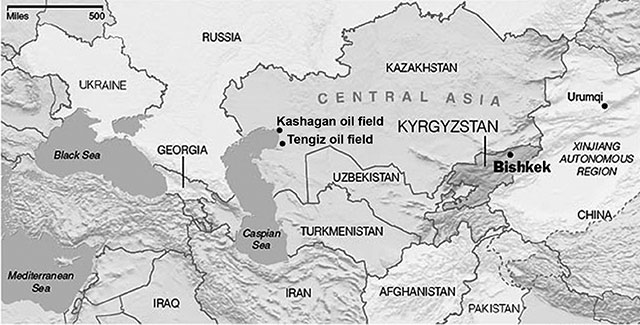
The same goes for being part of “international monopolist capitalist associations which share the world.” For all the talk of “partnership,” post-Soviet capitalist Russia has been treated as an outsider, to be dealt with warily. Although Russia applied to join the World Trade Organization (WTO) in 1993, it was not admitted until 2012, more than a decade after China. The Russian Federation is still excluded from the Organization of Economic Cooperation and Development (OECD), the club of leading capitalist countries, which has been expanded to include Poland, Hungary, Slovakia, Mexico and the Czech Republic. The NATO (North Atlantic Treaty Organization) imperialist military alliance has been expanding right up to Russia’s borders. And now Russia has been kicked out of the Group of Eight leading powers.
Lenin’s definition of imperialism had several elements, and some countries might qualify as imperialist by most but not all criteria. Lenin himself pointed to “a country most backward economically (Russia), where modern capitalist imperialism is enmeshed, so to speak, in a particularly close network of pre-capitalist relations.” Yet despite its economic weakness and backwardness, the tsarist empire acted as the “policeman of Europe” in the mid-19th century, crushing revolutions in Hungary and Poland; and during the Balkan Wars on the eve of World War I, it was seen as the protector of the southern Slavs against the Austro-Hungarian Empire. So Russia’s economy is not dominated by finance capital, it is not a major exporter of capital and it has not gained full admittance to the imperialist clubs, but what of its geopolitical role?
Pröbsting in his tract claims that “Russian imperialism already dominates or at least plays a central role in oppressing a number of Central Asian and Eastern European semi-colonies.” He claims that one of the 28 tables he prints (No. 9) shows that:
“Russia’s monopolies are investing in mostly semi-colonial Central Asia and Eastern Europe, as well as in Western imperialist Europe and in the semi-colonial Balkans. From these figures we can conclude that Russian monopolies derive significant extra-profit from their foreign investments in the semi-colonial countries in Eastern Europe, the Balkans, and Central Asia.”
The figures show nothing of the sort,
giving no indication of actual amounts of investment.
With this sleight of hand, he is hoping that readers won’t
recall that a previous table (No. 4) showed that less than 4%
of Russia’s foreign investment went to Central Asia, Eastern
Europe and the Balkans. Even if a portion of transfers to tax
havens are actually investments in offshore Russian companies,
such as Lukoil’s U.S. operations headquartered in the British
Virgin Islands, very little of these are invested in Central
Asia and Eastern Europe.

Tengiz oil field: U.S., European imperialists are exploiting Central Asian resources. (Photo: New York Times)
For example, the statistics showing US$2.5 billion of Russian foreign investment (0.7% of the total) in Kazakhstan certainly understate the actual amount. Several sources put the real figure at US$7 billion. But this is less than the $9.7 billion corresponding to U.S. firms, and less than 8% of the total foreign investment in the country (which accounts for four-fifths of all foreign investment in Central Asia).11 That is because the investments are concentrated in the petroleum industry, including the giant Tengiz oil field operated by a consortium led by Chevron and Exxon and the mammoth project at Kashagan, undertaken by a consortium led by Eni (Italy), BP (Britain), Statoil (Norway), Mobil, Royal Dutch Shell and Total S.A. (France). The Russian Rosneft and Lukoil only have minor fields producing far less than the Austrian OMW.
As for dividing up the world territorially, Russia hasn’t been notably successful in that department either. While Moscow’s rulers have waged two brutal, dirty wars to prevent the secession of Chechnya from the Russian Federation, they have accepted the independence of the non-Russian Soviet republics. Yeltsin even encouraged them, playing to a chauvinist sentiment that Russia should stop subsidizing the rest of the USSR. Putin has declared that “the collapse of the Soviet Union was a major geopolitical disaster of the century,” not because of any lingering affinity for socialism, however perverted and negated by Stalinism, but on the nationalist grounds that “tens of millions of our co-citizens and compatriots found themselves outside Russian territory” (address to the federal assembly of the Russian Federation, April 2005).
There is no doubt that Putin would like to restore the “glory” and power of the Russian Empire, but post-Soviet capitalist Russia has not been and still is not in a position to do so. Moscow has not turned the screws on the Baltic Republics, although their reactionary capitalist leaders have excluded several hundred thousand ethnic Russians from citizenship in Estonia and Latvia on the basis of Nazi-style “blood laws,” requiring ethnic Russians to be naturalized, renounce Russian citizenship and pass discriminatory language exams. In all three countries SS and police battalions of Nazi collaborators during World War II are hailed as national heroes, including those who executed Communists and slaughtered tens of thousands of Jews.
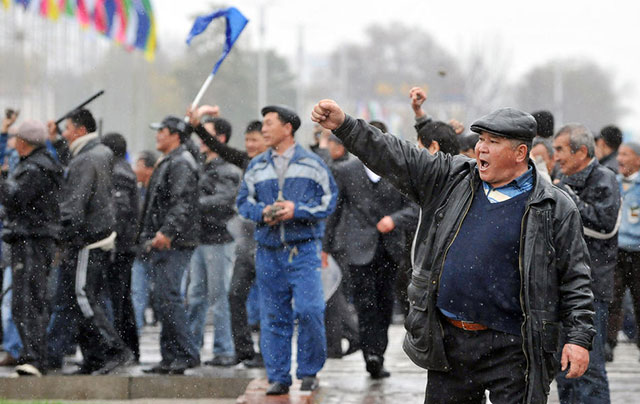
Washington engineered 2005 “Tulip Revolution” (above) in Kyrgyzstan, Central Asia, providing printing presses and financing opposition groups while maintaining military base in Manas to supply U.S. occupation forces in Afghanistan.
In ex-Soviet Central Asia there are no Russian military bases, nor has Moscow used military pressure to dominate the region. The U.S., on the other hand, has a base in Manas, Kyrgyzstan, a staging point for supplying the imperialist occupation force in Afghanistan. Washington also poured hundreds of millions in aid into the country, including tens of millions of dollars to promote “democracy” and “civil society.” Using the conduit of the National Endowment for Democracy, Washington financed Kyrgyz opposition groups who also used a Freedom House printing press to prepare the 2005 “Tulip Revolution,” which overthrew the government of Askar Akayev and installed Kurman Bakiyev as president.12 Bakiyev in turn was overthrown in 2010 by oppositionists feeding off discontent over the U.S. base and endemic government corruption.
In Georgia, the U.S. engineered the so-called “Rose Revolution” in November 2003 to oust the government of former Soviet foreign minister Eduard Shevardnadze, using a network of U.S.-funded “non-governmental organizations” (NGOs) and U.S.-trained operatives from Serbia who had organized the overthrow of Slobodan Milosevic in 2000. Shevardnadze’s replacement, U.S.-educated Mikheil Saakashvili (who got an advanced law degree from Columbia University on a State Department scholarship), was backed by financier George Soros, whose empire of “Open Society” NGOs was also active in Ukraine in 2004 and again in 2013-14. Having taken power in a coup, Saakashvili soon applied for Georgian membership in NATO.
In 2008, Saakashvili set off hostilities and eventually a five-day war with Russia by military provocations in the pro-Russian enclaves of Abkhazia and South Ossetia, where Russian peacekeeping troops had been stationed since Georgia tried to suppress revolts by the local population in 1991-92. In response to Georgian attacks, Moscow dispatched Russian troops who drove out the invaders, but then continued on into Georgia in what became a reactionary Russo-Georgian war. But even NATO officials and observers of the OSCE (Organization for Security and Cooperation in Europe) blamed Georgia for starting the conflict, hoping to get NATO to intervene and fast-track its application for membership in the imperialist military alliance. Far from being expansionist, the Russian military action was essentially defensive.
So in talking about an imperialist power that exploits
Central Asian and Caucasian semi-colonies, reaping
super-profits by exporting capital to exploit their natural
resources, intervening with massive financing to influence
local politics, organizing coups and maintaining military
bases, who has done that in the post-Soviet period is not
Russia but the United States. Certainly Russia’s capitalist
rulers seek to dominate the geopolitical space around their
reduced domain and to lord it over submissive weaker states.
Putin clearly dreams of doing so. But at present Russia can
only ward off the attacks of aggressive U.S. imperialism and
its NATO imperialist allies who, sometimes through regional
puppets, are determined to smash any challenge to their global
hegemony.
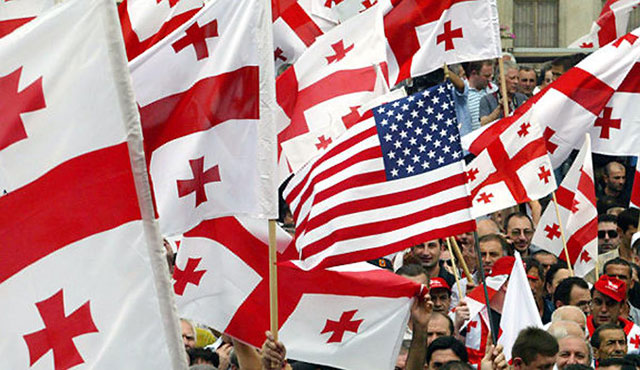
U.S. imperialists also engineered 2003 “Rose Revolution” in Georgia, installing Mikheil Saakashvili as puppet president, who in 2008 launched attack on pro-Russian enclaves of Abakhazia and South Ossetia, hoping to spur membership in NATO. (Photo: Shakh Alvazov/AP)
Russia as a Transitional Capitalist Country and Regional Power
Contrary to the social-democratic purveyors of imperialist
propaganda against “Russian imperialism,” Lenin did not divide
the world exclusively into imperialists and colonies or
semi-colonies. In his pamphlet on Imperialism, the
Bolshevik leader referred in several places to “non-colonial
and semi-colonial countries” (such as Persia, China and
Turkey), to “a number of transitional forms of state
dependence” including Argentina (“almost a British commercial
colony”) and Portugal (“a British protectorate”), and more
generally to “the transitional forms which are to be found in
all spheres of nature and society.” His point was that they
are all “links in the chain of operations of world finance
capital,” part of “a general system,” imperialism.
Russia today is such a transitional capitalist country, neither a semi-colony nor an imperialist state – not yet. Another example of an intermediate capitalist country is Greece.13 Geopolitically Russia is a regional power with imperial ambitions. It’s not unique. South Africa, both under the apartheid regime and now under black capitalist neo-apartheid, has sought to control the southern parts of the African continent. Even larger semi-colonial countries can play this role: Iran under the shah and Khomeini and his heirs has sought to dominate “its” region, including the “Persian” Gulf statelets. Brazil acts as a sheriff for Yankee imperialism in the Caribbean, supplying mercenary troops for the U.S./U.N. occupation of Haiti. Putin’s Russia plays hardball with Ukraine over gas supplies and prices? For decades Brazil imposed below-cost payments to Paraguay for electricity from the Iguazu Falls.
Marxists oppose the imperial and great power ambitions of such regional powers while concentrating our fire on the real imperialists who like to carry out their aggression posing as defenders of human rights, democracy and the like. Woodrow Wilson did so in the first imperialist world war, the “democratic” imperialists did so in World War II, Bill Clinton did so in twice attacking Serbia, and today liberal U.S. Democrat Barack Obama, French “socialist” François Hollande and British Tory David Cameron sound the same theme in sponsoring Islamist “ethnic cleansers” in Syria and Nazi pogromists in Ukraine. Today, the main threat to working people in the clash over Ukraine is the imperialist-backed junta of ethnic-nationalist fascists and free-market rightists in Kiev, not some “Russian imperialism.”
So what about the claims of Russian aggression against “poor little Ukraine”? In the first place, Putin’s incorporation of Crimea was able to take place without firing a shot because it had the overwhelming, enthusiastic support of the local population. Crimea was historically part of Russia and the large majority of its population culturally Russian, and it was “gifted” to Ukraine only in 1954 by Nikita Khrushchev. The administrative change made little difference to people at the time as Ukraine and the Russian republic were part of a single state, the Soviet Union. Residents have continued to identify with Russia in part because of the economic dominance of the peninsula by the Russian Black Fleet base at Sevastopol, and because many in the 95% Russian-speaking population (including ethnic Russians and ethnic Ukrainians) are army and navy veterans.
The Internationalist Group and League for the Fourth
International supported the self-determination of Crimea and
its joining the Russian Federation. Russia’s military action,
far from being an act of aggression, facilitated the exercise
of this democratic right in repudiation of the
imperialist-backed Ukrainian-nationalist Kiev junta, which is
hostile to (and despised by) the population of
Russian-speaking regions of Ukraine. Russian intervention was
also a defensive move to forestall military action by a
hostile, NATO-backed Ukraine to seize Sevastopol. This is not
only home port to the Black Sea Fleet, but is vital for
Russian exports because it dominates access to Russia’s only
major warm water port (which doesn’t freeze in winter),
Novorossiysk. If NATO ever got control of Sevastopol they
would use it to strangle Russia economically.
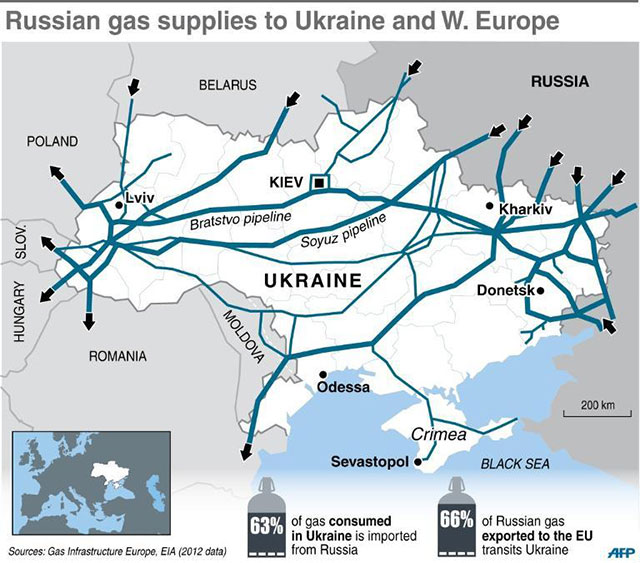
As for all the talk of the Russian bear gobbling up southeastern Ukraine, this is crude Cold War fear-mongering. That would result in a rump Ukrainian state dominated by a virulently anti-Russian nationalist government based in western Ukraine through which most of the 12 pipelines carrying Russia gas to Europe run. They could be turned off in a flash, and while Russia has now opened the Nord Stream pipeline under the Baltic Sea, this can only carry a fraction of Russian gas exports to Europe. Moreover, the population of eastern Ukraine is more mixed than in Crimea, with a strong minority of native Ukrainian speakers. A Russian takeover (as opposed to self-rule) would doubtless face endless Ukrainian-nationalist attacks. In one of its few lucid moments, the New York Times (13 May) recognized this, editorializing:
“Mr. Putin has given every indication that his real goal is not to annex any more Ukrainian territory but to transform Ukraine into a federation under a weak and neutral Kiev government permanently dependent on Russia.”
What the most aggressive imperialist warmongers want, in contrast, is a Ukraine dependent on the West which would be a permanent military threat to Russia. Such a configuration would inexorably point to war. Provocations by Ukrainian ultra-rightists, or others, would be unpreventable. No “peace” arrangements could avert that danger, so that nuclear deterrence would be back, and with it the doctrine of “Mutually Assured Destruction.” The Pentagon understands this well, which is why it has so far not acted on Ukrainian (or Georgian) requests to join NATO. The Kremlin even more so sees this perilous scenario on the horizon, and has moved to avert it.
Ukraine: Neo-Colony of Post-Soviet Russia?
Aside from the Cold War anti-Russian propaganda, there remains the question of Ukraine’s relationship to Russia: under the tsarist empire, in the Soviet Union, and since the destruction of the USSR and restoration of capitalism. Is it true, as the American ISO claims, that Russia is “Ukraine’s past and present imperial overlord”? This “captive nations” refrain is definitely the view of the leaders of the Kiev junta, “prime minister” Arseniy Yatsenyuk and “president” Oleksandr Turchynov and Ukrainian nationalists generally who justify the military assault on eastern Ukraine with the claim that they are fighting to throw off the Russian imperial yoke (even as they seek to become a semi-colony of the imperialist European Union).
Ukraine was certainly an oppressed nation under tsarism, one of many in the Romanovs’ “prison house of peoples.” Ukrainian culture was persecuted and the Ukrainian language was banned from the schools from 1804 on. In addition, by the late 1800s Ukraine was home to 20% of all European Jews, who were beset by tsarist repression and pogroms, leading many to flee Ukraine. But many remained and Ukrainian Jews played a prominent role in the socialist movement, one of the reasons for the Odessa pogrom by tsarist Black Hundreds at the height of the 1905 Russian Revolution.
We have noted how during the Civil War following the 1917 October Revolution, Lenin and Trotsky united Ukrainian and Russian Bolsheviks and leftward-moving Ukrainian nationalists in a single Communist Party. A short-lived Donetsk—Krivoy Rog soviet republic in the east was integrated into the Ukraine Soviet Socialist Republic, with its capital in Kharkiv. In his speech to the Russian parliament over Crimea, Putin complained: “After the revolution, the Bolsheviks, for a number of reasons – may God judge them – added large sections of the historical South of Russia to the Republic of Ukraine. This was done with no consideration for the ethnic make-up of the population” (RT, 19 March). Russian nationalists blame Trotsky for this, which was key to creating a multi-national Ukraine. Ethnic homogeneity is a chauvinist program.
In the early years of Soviet Russia, the Bolsheviks followed a policy of “korenizatsiia,” or indigenization, promoting the use and development of native languages in non-Russian areas of the USSR. The use of Ukrainian was encouraged in the government and schools. But as part of Stalin’s nationalist dogma of building “socialism in one country,” an aggressive campaign of Russification was launched: in 1929 Ukrainian intellectuals were arrested; a few years later Ukrainian instruction in the schools was banned and newspapers switched to Russian. In addition, there was the terrible toll of forced collectivization, in which several million died in the 1932-33 famine. And, as Trotsky noted, Stalin’s bloody purges of Communists in the late 1930s hit the Ukrainian CP harder than anywhere.
This was not the entire story of Ukraine’s history in the Soviet Union, however. From the 1930s on, eastern Ukraine became the industrial powerhouse of the USSR. Following former Ukrainian party chief Nikita Khrushchev’s 1954 accession to power in Moscow, language policy was loosened and Ukrainian was once again used in schools and media, although Russian was still prevalent as was repression of all dissidents – pro- and anti-socialist alike. Similarly under Ukrainian Leonid Brezhnev, who succeeded Khrushchev in the Kremlin from 1964 to 1982. Incomes and supplies of consumer goods rose and by 1991, living standards in Ukraine were slightly higher than in the Russian republic. Then counterrevolution devastated the economy and incomes fell by up to two-thirds. Capitalism threw millions of Ukrainians into poverty.
Today incomes are much higher in Russia than in Ukraine: pensions in Russia are double those in Ukraine (one reason why even ethnic Ukrainians voted for Crimea to join Russia). This is mainly due to Russia’s boom in oil and gas production and the international rise of energy prices. Yet despite all the propaganda about Russian use of natural gas to “blackmail” Ukraine, even after prices of Russian gas to Ukraine were more than doubled in 2006, the average price ($130 per thousand cubic meters) was barely 40% of that charged to Germany ($320/mcm).14 Far from extracting superprofits from gas sales to Ukraine, Russia has greatly subsidized Ukrainian industry and consumers in order to keep the country friendly, while Ukraine has periodically used its control of the pipelines and storage facilities to siphon off huge quantities of gas.15
The other major difference between the Ukraine and Russian economies is the role of the “oligarchs.” In both countries, the demise of the socialized economy was marked by wholesale looting, as privatized enterprises were handed out to cronies for a pittance. This is typical of the formation of a new capitalist class, which almost always is the result of state promotion. The difference between Russia and Ukraine is that, beginning in 2000 Putin clawed back some of the ill-gotten gains, beefed up state-owned strategic sectors and brought the capitalist boyars (princes) to heel, with some fleeing to exile (Berezovsky, Gusinsky) and others jailed (Khodorkovsky). In Ukraine, the looting never stopped, and the oligarchs have continued to have free rein, no matter who was president.
Russian companies have limited clout in Ukraine, as
“pro-Russian” and “pro-Ukrainian” oligarchs have united to
keep their richer Russian cousins out. There has been a
tug-of-war over oil refineries, with the Russian company
Tatneft ousted at gunpoint from the largest plant
(Keremenchug) in 2007, while a court recently seized a smaller
Odessa refinery which had gone back and forth between Russian
and Ukrainian ownership. The largest foreign-owned refinery
today (Kherson) belongs to the Kazakh state oil company.
Russian firms have also been largely excluded from the steel
industry: when the largest mill, Kryvorizhstal, was privatized
in 2004, the Russian company Severstal was excluded, and the
initial award to eastern Ukrainian steel baron Rinat Akhmetov
was reversed on presidential orders. The plant was then sold
to Arcelor Mittal Steel with a loan from Citigroup. In 2010
the government awarded the second largest steel complex, the
Ilyich Steel and Iron Works, to Akhmetov in order to keep
Russian investors out.16
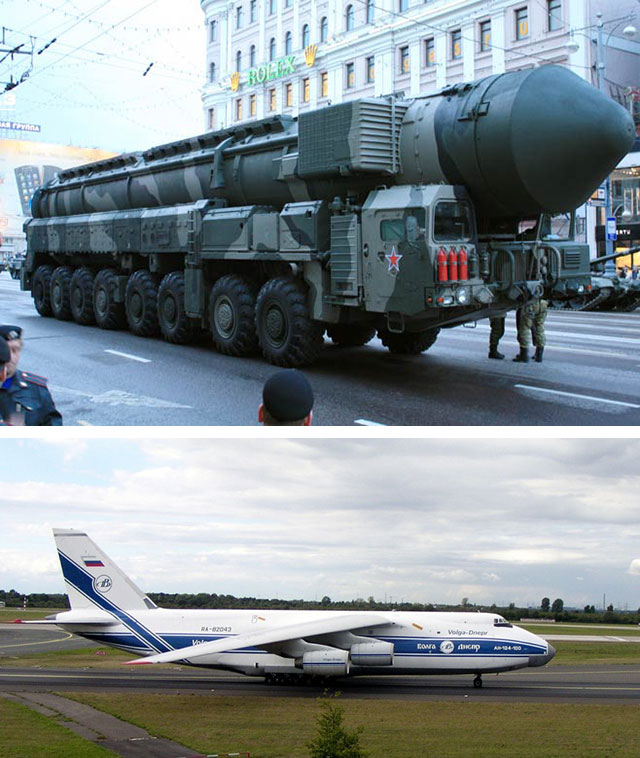
Ukraine a semi-colony of Russia? Ukraine does not have typical semi-colonial economy based on resource extraction but is a heavily industrialized country, the tenth-largest arms exporter and tenth-largest steel producer in the world. (Top) Russian R-36 intercontinental ballistic missile launcher and (bottom) Antonov 124 cargo plane, both made in Ukraine and sold mainly to Russia.
Ukraine does not have a typical semi-colonial economy based on resource extraction. It is heavily industrialized and is the tenth largest arms exporter in the world (and in 2012 the fourth-largest), ahead of Israel and Sweden, producing not only light arms but a full range of heavy weaponry including tanks.17 Ukraine is also the tenth largest steel producer in the world.18 And contrary to the news reports about a “rust belt,” heavy industry in eastern Ukraine has revived somewhat, while light manufacturing plants in the west have closed due to the competition of cheaper imports. The reality is that Russia has been a main customer of the Ukrainian iron, steel, metal and weapons plants. Ukraine’s aircraft industry based in Kiev and Kharkov works in close collaboration with Russian plants in Samara and Voronezh.
People in eastern Ukraine are well aware that if the country swings into the European Union orbit, most of this industry would be destroyed, as the U.S. and European capitalists snap up a few choice morsels and the workers are condemned to unemployment.
Overall Ukraine, like Russia, is an intermediate, transitional capitalist country, albeit one that is still mired in post-counterrevolution economic malaise and is far weaker militarily. But while workers’ wages and income levels are at poverty levels, that is not because of superexploitaiton by Russia. It is centrally because Ukraine’s capitalist rulers have growth filthy rich by looting the country’s riches. In fact, many Ukrainian oligarchs have used their accumulated wealth to buy up foreign companies. Thus in addition to Sergei Taruta who owns major steel mills in Ukraine, Poland and Hungary, Ihor Kolomoyski’s Privat Group controls banks, airlines, oil refineries, iron and steel mills, ferroalloy plants in Ukraine, Romania, Poland, Georgia and Russia, and Australian Consolidated Minerals which has 10% of global manganese production. Not to mention pipe magnate Viktor Pinchuk and “chocolate king” Petro Poroshenko, among others.
The issue of language has been a lightning rod for anti-Russian Ukrainian nationalist sentiment. This is in large part because of the large ethnic Russian population in the east and south, much of which has little allegiance to the Ukrainian state, but just as importantly because the actual number of Russian speakers is far greater. While 30% of the population give Russian as their native language, 46% say they speak Russian at home, over half say it is their everyday language and Russian is the most common language in media and business. Moreover, in the central Ukrainian regions, a large percentage speak Surzhyk, with a mixture of Ukrainian and Russian vocabulary, so that “pure” Ukrainian is the dominant language only in the west. Thus the ethnic nationalists are trying to impose the use of Ukrainian on a reluctant population.
The decision by the Ukrainian Rada (Supreme Council) on the day after the coup to eliminate the official status of the Russian language in eastern Ukraine was no fluke. Not only the fascists but even the “moderate” nationalist bourgeois parties voted for this last fall. It is common when nationalist movements gain power that they seek to impose a national language, and Ukrainian nationalists are vexed by the fact that Russian remains the predominant language. Marxist internationalists, in contrast, oppose the imposition of official languages or state privilege for any language.19 Demands that all Ukrainian citizens must speak Ukrainian, that official business and school instruction must be in Ukrainian, paralleling Estonia and Latvia, are discriminatory and chauvinist, and we oppose them just as we oppose the French-language Law 101 in Quebec that seeks to legislate the use of French by English-speakers and immigrants.20
In sum, the relation of Russia and Ukraine today is not one of imperial overlord and semi-colonial vassal but of two intermediate level capitalist states, notwithstanding differences in their relative power. Canada and the United States are both imperialist states, and while the U.S. is far more powerful, there is no qualitative difference between them. Marxists must take into account the long history of Ukrainian oppression at the hands of the tsarist Russian Empire and the Great Russian Stalinist chauvinists, but Ukrainian anti-Russian nationalism is no less reactionary (and like all nationalism, bourgeois). While also combating Russian nationalism in eastern Ukraine, Trotskyists fight for proletarian internationalism against all the capitalist exploiters, and particularly against the imperialists, their Ukrainian bourgeois puppets and fascist attack dogs. ■
- 1. “The New World Order,” The Economist, 22 March.
- 2. See “Down with the Imperialist-Backed Fascist/Nationalist Coup in Ukraine!” The Internationalist, March 2014.
- 3. Sergei Guriev and Andrei Rachinsky, “The Role of Oligarchs in Russian Capitalism,” Journal of Economic Perspectives, Winter 2005.
- 4. World Bank data: http://data.worldbank.org/indicator/NV.IND.TOTL.ZS
- 5. Pröbsting speaks for the Revolutionary Communist International Tendency (RCIT), a 2011 split from the League for a Fifth International led by the British Workers Power group. While claiming to be Trotskyist, both the RCIT and its progenitor declare the Fourth International dead, not only organizationally but also programmatically. Workers Power was a mid-1970s split from the Cliffite International Socialists. Today they all declare China “state capitalist” just as Cliff did with Russia during the first Cold War. In each case they are inventing a label in order to justify refusing to defend degenerated/deformed workers states against imperialism.
- 6. United Nations Conference on Trade and Development (UNCTAD), World Investment Report 2013, Table of Top 100 TNCs from Development and Transition Economies (2011).
- 7. Figures in this paragraph on outward and inward stock of foreign direct investment are for 2012, UNCTAD, World Investment Report 2013, FDI/TNC database.
- 8. Aleksei Kuznetsov, “Russian Multinationals FDI Outflows Geography: the Emerging Dominance of Greater Europe,” European Researcher [Vol. 67:1-2, 2014]
- 9. “President Vladimir Putin’s calls for domestic companies to repatriate their funds back home from offshore jurisdictions have fallen on deaf ears” (“Russian Investors Flock to Virgin Islands After Cypriot Crisis,” Moscow Times, 18 August 2013).
- 10. “Russian Steel Billionaire Mordashov Seeks U.S. Pull Out,” Bloomberg, 16 May 2014.
- 11. OECD Investment Policy Reviews, Kazakhstan 2012: Foreign Direct Investment in Kazakhstan (2012).
- 12. “U.S. Helped Prepare the Way for Kyrgyzstan’s Uprising,” New York Times, 30 March 2005.
- 13. We have noted elsewhere that Greece is neither a semi-colonial country nor a full-fledged imperialist country but “a sub-imperialist power whose capitalists own the largest shipping fleet in the world (though mostly not sailing under the Greek flag); whose banks have historically had a privileged position in the eastern Mediterranean and are now buying up banks and companies throughout the Balkans; and which economically dominates Macedonia and Albania” (“Greece on the Razor’s Edge,” The Internationalist No. 32, January-February 2011).
- 14. S. Pirani, Ukraine’s Gas Sector (Oxford Institute for Energy Studies, June 2007).
- 15. An article by two Brookings Institution experts notes, “The simple fact is that Russia today supports the Ukrainian economy to the tune of at least $5 billion, perhaps as much as $10 billion, each year” (Clifford Gaddy and Barry Ickes, “Ukraine: A Prize Neither Russia Nor the West Can Afford to Win,” Brookings, 22 May). This subsidy is not limited to cheap gas, but also includes Ukraine’s heavy manufacturing and defense industries which are almost entirely dependent on exports to Russia. When Russia stopped ordering railroad locomotives and rolling stock last year, Ukraine lost billions of dollars and its plants effectively shut down.
- 16. Sławomir Matuszak, The Oligarchic Democracy: The Influence of Business Groups on Ukrainian Politics (OSW Studies, 2012).
- 17. SIPRI (Stockholm International Peace Research Institute) Yearbook, 2013.
- 18. “World Steel Statistics Data 2013,” World Steel Association, January 2014.
- 19. “In particular, Social-Democrats reject a ‘state’ language” and oppose “any ‘state’ privileges for any one language” (V.I. Lenin, “Theses on the National Question,” June 1913). The Bolsheviks did not make Russian the state language, and in fact promoted non-Russian languages in teaching and administration under the policy of “korenization” (or indigenization), including use of minority languages is districts with ethnic minorities, among them Russian speakers in eastern Ukraine.
- 20. At the same time, we oppose company policies requiring the use of the language preferred by management.
